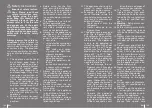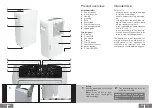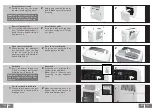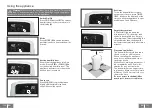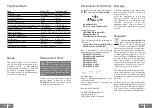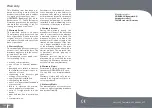
EN
150
EN
151
with children. The function-
ality of the appliance could
be damaged.
25.
Children and disabled peo-
ple are not allowed to use
the unit without supervi-
sion.
26.
Close doors and windows
when operating the appli-
ance, so that it can work ef-
fectively.
27.
Empty the water tank regu-
larly. Please observe, that
high humidity can cause the
water tank to fill quickly.
28.
The filter on the backside
of the appliance must be
cleaned regularly to guaran-
tee an optimal air inlet.
Cabling
Check that cabling will not be
subject to wear, corrosion, ex-
cessive pressure, vibration,
sharp edges or any other ad-
verse environmental effects.
The check shall also take into
account the effects of aging or
continual vibration from sourc-
es such as compressors or fans.
Removal and evacuation
When breaking into the refriger-
ant circuit to make repairs – or
for any other purpose – con-
ventional procedures shall be
used. However, it is important
that best practice is followed
since flammability is a consid-
eration.
The following procedure shall
be adhered to:
•
remove refrigerant;
•
purge the circuit with inert
gas;
•
evacuate;
•
purge again with inert gas;
•
open the circuit by cutting or
brazing.
The refrigerant charge shall be
recovered into the correct re-
covery cylinders. The system
shall be “flushed” with OFN to
render the unit safe. This pro-
cess may need to be repeated
several times. Compressed air
or oxygen shall not be used for
this task.
Flushing shall be achieved by
breaking the vacuum in the sys-
tem with OFN and continuing
to fill until the working pressure
is achieved, then venting to at-
mosphere, and finally pulling
down to a vacuum. This pro-
cess shall be repeated until no
refrigerant is within the system.
When the final OFN charge
is used, the system shall be
vented down to atmospheric
pressure to enable work to take
place. This operation is abso-
lutely vital if brazing operations
on the pipe-work are to take
place.
Charging procedures
In addition to conventional
charging procedures, the fol-
lowing requirements shall be
followed.
•
Ensure that contamination
of different refrigerants does
not occur when using charg-
ing
•
equipment. Hoses or lines
shall be as short as possi-
ble to minimise the amount
of refrigerant contained in
them.
•
Cylinders shall be kept up-
right.
•
Ensure that the refrigera-
tion system is earthed prior
to charging the system with
refrigerant.
•
Label the system when
charging is complete (if not
already).
•
Extreme care shall be taken
not to overfill the refrigera-
tion system.
Prior to recharging the system
it shall be pressure tested with
OFN. The system shall be leak
tested on completion of charg-
ing but prior to commissioning.
A follow up leak test shall be
carried out prior to leaving the
site.














